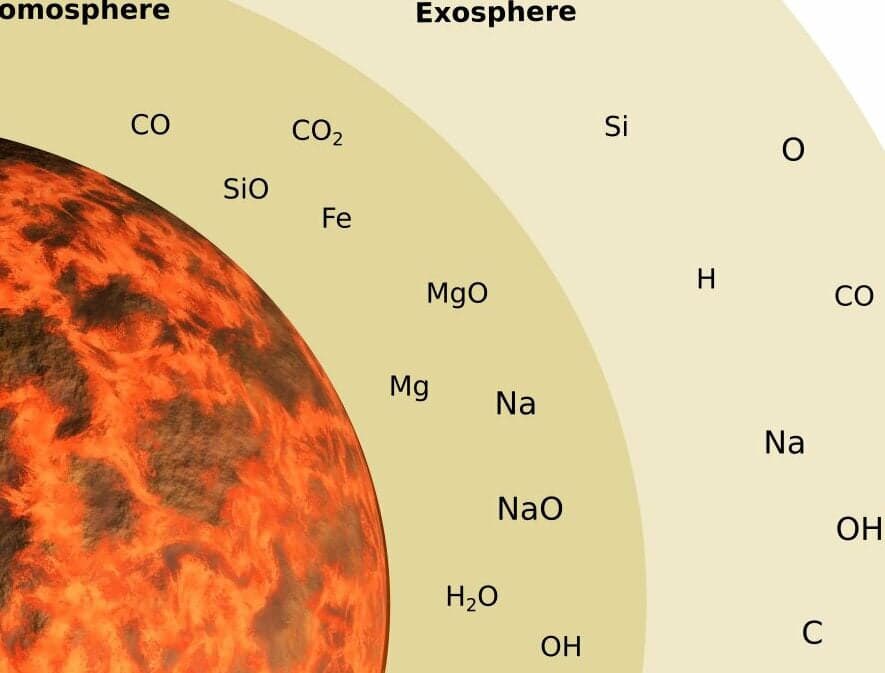Mercury, the planet closest to the Sun in our Solar System, possesses a unique atmosphere. In fact, it revolves around the Sun at a faster pace compared to the other planets, which earned it the name “Mercury” by the Romans, after their swift god of commerce. To shed some light on this enigmatic planet, we have gathered a collection of fascinating details about its atmospheric composition. Waste no time and delve into the intriguing world of Mercury!
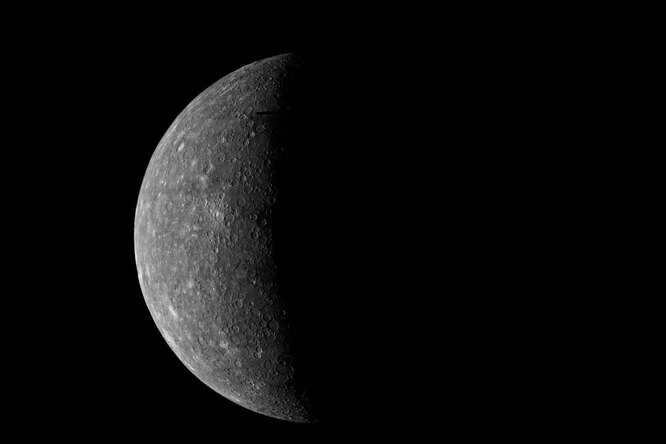
Is there an atmosphere on Mercury?
Mercury does possess an atmosphere, although it is extremely sparse. Unfortunately, this thin atmosphere fails to shield the planet from meteorite impacts or to trap heat effectively.
If there was a gas envelope, it existed approximately 4.6 billion years ago and was rapidly dispersed by various factors. The weak gravity and the close proximity to the Sun likely played a role in this dispersion, as the Sun’s solar wind would have effectively “washed away” the atmosphere. Due to the lack of atmosphere, Mercury’s surface is covered in craters. Around 4 billion years ago, a colossal asteroid measuring 100 km in diameter collided with Mercury, generating an impact energy equivalent to that of a trillion megaton bombs. This resulted in the formation of a massive crater spanning approximately 1550 km, now referred to as the Heat Plain.
The constitution of Mercury’s atmosphere
Scientists posit that the composition of the atmosphere undergoes a constant replenishment through solar wind particles and volcanic degassing. Additionally, it is supplemented by the radioactive decay of elements on the planet’s surface, as well as space dust and debris that frequently descend upon Mercury. Without these sources, even the remnants of the atmosphere would have dissipated long ago. Mercury’s atmosphere primarily comprises oxygen (42.0%), sodium (29.0%), hydrogen (22.0%), helium (6%), and potassium (0.5%). Furthermore, carbon dioxide, water, nitrogen, xenon, krypton, and neon are also potentially present. In 2008, the Messenger spacecraft, operated by NASA, detected water vapor in the atmosphere. Such vapor may arise from the colliding hydrogen and oxygen atoms.
Finding water vapor indicates the presence of water ice on the planet. Water ice has been discovered at the polar regions of Mercury, where it is shielded from sunlight exposure.
The Composition and Characteristics of Mercury’s Atmosphere
Despite its small size, Mercury’s atmosphere is comprised of four distinct layers: the lower, middle, upper, and exosphere. The lower layers experience relatively warm temperatures, reaching as high as -63.15°C. This warmth is generated by the presence of dust particles in the air and thermal radiation. The dust particles also contribute to the brown color of Mercury’s atmosphere. Similar to Earth, air currents exist within the middle layer. The upper layers are heated by the solar wind, resulting in significantly higher temperatures compared to the planet’s surface. The exosphere, beginning at an altitude of only 200 km, does not have well-defined boundaries and seamlessly transitions into outer space.
Additional fascinating information about Mercury
- Mercury is gradually decreasing in size. This celestial body is composed of a solitary continental plate surrounding a cooling iron core. As the core cools down, it starts to solidify. This phenomenon accounts for the planet’s shrinking and contraction. Furthermore, this process contributes to the creation of rocks and surface blemishes.
- The Mariner 10 spacecraft made a remarkable discovery that unveiled the presence of a magnetic field on the planet Mercury. According to the prevailing theories, planets can only generate a magnetic field if they rotate rapidly and possess a molten core. However, Mercury defies these expectations as it is significantly smaller in size (only about one-third the size of Earth) and its core should have cooled down a long time ago. Interestingly, Mercury’s magnetic field is approximately three times stronger in the northern hemisphere compared to the southern hemisphere. Scientists have proposed a model suggesting that Mercury’s iron core undergoes a transformation from liquid to solid at the outer boundary rather than the inner boundary.
- Mercury, being the closest planet to the Sun, experiences a much faster revolution around the Sun compared to the other planets.
TechInsider Network Edition
Founder of “Fashion Press” LLC: 119435, Moscow, Russia. Moscow, Bolshoy Savvinsky per. 12, p. 12, str. 6, floor 3, room II;
Editorial office address: 119435, Moscow, Bolshoi Savvinsky per. 12, p. 12, str. 6, floor 3, room II;
Editor-in-Chief: Nikita Vasilenok
Editorial office e-mail address: [email protected]
Editorial office phone number: +7 (495) 252-09-99
Information product label: 16+
The network edition is registered by the Federal Service for Supervision in the Sphere of Communications, Information Technologies and Mass Media, registration number and date of decision on registration: series EL No. FS 77 – 84123 dated November 09, 2022.
© 2007 – 2023 “Fashion Press” Ltd.
By publishing content on the Website, the User authorizes “Fashion Press” LLC with non-exclusive privileges to utilize, duplicate, distribute, generate derivative works, and present the materials to the public at no cost.
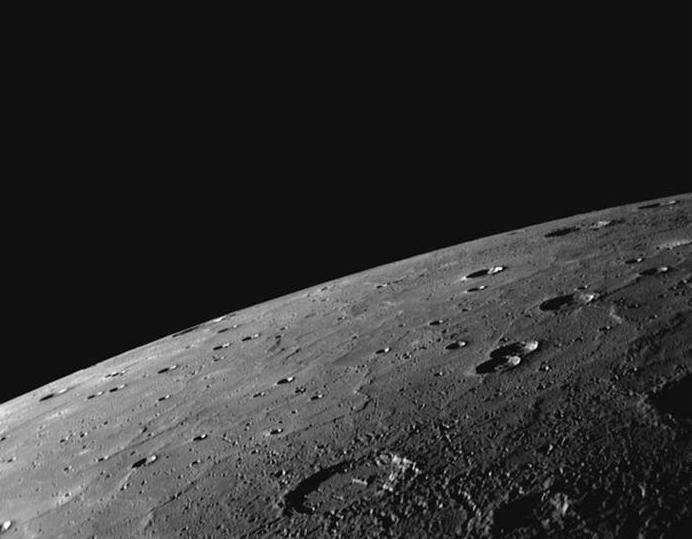
Although it may not possess the same level of power as Earth’s and is even smaller than Mars, this planet does have its own unique characteristics that are currently being explored by astronomers and the MESSENGER spacecraft.
The planet’s original gaseous shell, if it ever had one, completely dissipated shortly after its formation approximately 4.6 billion years ago. This phenomenon could be attributed to the planet’s low gravity and its close proximity to the Sun. The solar wind generated by the Sun may have blown away the planet’s gaseous shell. As a result, the planet is now nearly invisible.
Composition
This unique shell is made up of elements such as oxygen, hydrogen, helium, sodium, potassium, and water vapor.
Astronomers theorize that it is continuously refilled from a variety of sources: particles from the solar wind, volcanic emissions, the decay of radioactive elements on the surface of Mercury, and interstellar dust and debris that the planet encounters during its orbit. If it weren’t for these sources, the shell would dissipate rapidly under the influence of the solar wind.
Composition of the atmosphere:
Oxygen 42.0%
Sodium 29.0%
Hydrogen 22.0%
Helium 6%
Potassium 0.5%
The remaining 0.5% consists of krypton, methane, water vapor, nitric oxide, and other gases.
In 2008, NASA’s MESSENGER spacecraft made a significant discovery of water vapor in the planet’s atmosphere. This water vapor is believed to be produced when hydrogen and oxygen atoms combine.
The presence of water vapor indicates the existence of water ice somewhere on the surface. Deposits of water ice have been found at the poles of the planet, specifically in the bottoms of craters that are permanently shadowed and never exposed to sunlight. You can find more information about this discovery here. Methane is thought to originate from volcanic activity, geothermal processes, and hydrothermal activity. However, methane is an unstable gas and requires a constant and highly active source, as it breaks down in less than a year.
Arrangement
Even though it is compact, it was segregated into four distinct tiers. These tiers include the lower, middle, upper, and exosphere. The lower tiers comprise a relatively warm zone (around 210 K). The warmth in the lower tiers is generated by dust particles in the atmosphere (whose diameter is 1.5 microns) and the thermal radiation emanating from the surface.
The brown color of Mercury is attributed to the dust present in its atmosphere.
Similar to Earth, Mercury has air currents in the middle part of its atmosphere. However, the upper layers of Mercury’s atmosphere experience higher temperatures due to heating from the solar wind. The exosphere of Mercury, which begins about 200 km from the surface, gradually transitions into space without any distinct boundaries.
Mercury’s magnetic field plays a crucial role in maintaining the planet’s structure. While gravity pulls gases towards the surface, the magnetic field prevents the solar winds from escaping, similar to Earth’s magnetosphere. This magnetic containment helps keep Mercury intact.
The solar wind is continuously blowing it away, and there are continual sources on the planet that are replenishing it. Hopefully, the MESSENGER spacecraft that is currently orbiting the planet will aid in discovering the sources of replenishment and expanding our understanding of the planet.
Astronomy enthusiasts are aware that when observing Mercury through a telescope, it may appear as though the planet lacks an atmosphere. However, this is not accurate. Studies conducted by multiple space programs have revealed that this celestial body does indeed possess a gaseous envelope, albeit a very thin one.
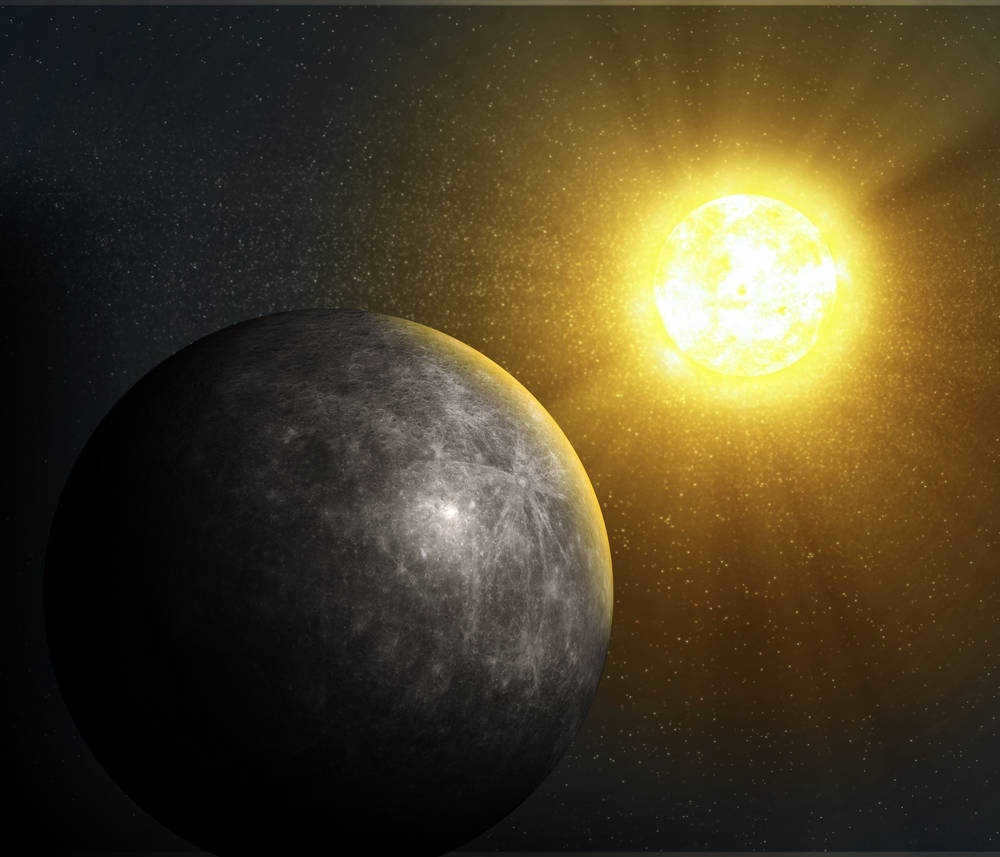
Atmospheric Composition of Mercury
The spherical shape of the outer gas-air shell can be observed not only on Mercury but also on other celestial bodies within the solar system. The atmosphere of Mercury is composed of a mixture of gases and dust. Scientists have categorized its structure into four layers:
- The lower layer, which is located near the surface;
- The middle layer;
- The upper layer;
- The exosphere, which borders with space.
The first of them is in contact with the planet’s surface. It is the hottest, with an average temperature of -63 ° C, as it is heated by the blowing dust and infrared radiation from the ground. It may seem like a small amount, but on the illuminated side of the planet’s surface, according to the readings from research vehicle sensors, it can reach up to +410 ° C. These extreme conditions can cause certain metals like lead and tin to melt, and when the Sun sets below the horizon, the average surface temperature drops to -162 ° C. The minimal warming of the atmosphere can be attributed to its high rarefaction, creating almost a vacuum. To put it into perspective, scientists believe that the temperature of outer space is around -270 ° C.
In the middle layer, processes resembling those on Earth take place. Here, flows of gases and dust are in motion, gradually dispersing. The upper part of the layer absorbs heat from the solar wind. The exosphere, which starts 200 km above Mercury’s surface, does not have clear boundaries due to its significant rarity.
Mercury has a comet-like tail that extends about 2.5 million kilometers.
The replenishment of atmospheric components occurs through various factors:
- volcanic activity;
- evaporation of metals and water glaciers;
- radioactive decay;
- hydrothermal processes;
- the influence of the solar wind.
Currently, there is a state of balance where the quantity of gaseous substance dissipating into outer space is approximately the same as the amount generated near the surface of the planet. The force of attraction on Mercury is extremely feeble. If we consider this characteristic of Earth as one, then on Mercury it is only 0.38.
The atmospheric composition
The planet’s atmosphere is a thin and rarefied gas shell that is not uniform. It consists of atoms of various chemical elements. Let’s examine the primary elements in descending order.
Oxygen and sodium
Oxygen is the dominant element in Mercury’s atmospheric composition. Research data indicates that it makes up approximately 42% of the atmosphere. Oxygen atoms are released from rock oxides due to meteorites, ionized particles from solar wind, and the dry evaporation of water ice, which bypasses the liquid phase and transitions directly from solid to gas. Atomic sodium is the second most abundant element, comprising about 29% of the atmosphere.
Hydrogen, helium, potassium and various other chemical elements
The composition of the atmosphere is also comprised of noteworthy quantities of hydrogen (22%) and helium (6%). These elements are present as a result of their contribution from the solar wind and from the planet itself. Additionally, there is a presence of potassium atoms (0.5%) in the composition. The remaining 0.5% consists of other impurities such as carbon dioxide, krypton, water vapor, and various other chemical elements.
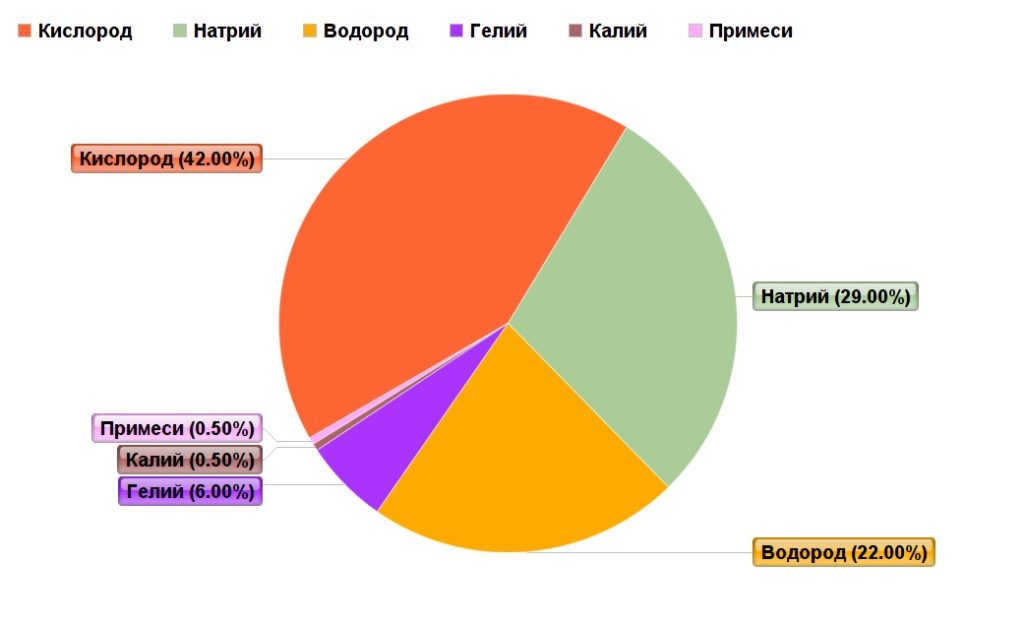

The Presence of Water Vapor
The surprise discovery of water vapor in Mercury’s atmosphere has puzzled scientists. It is believed to come from hidden glaciers in shaded polar craters. Water quickly transitions from a solid to a gaseous state at low temperatures. Additionally, water vapor molecules may be formed through the impact of ionized particles on free hydrogen and oxygen atoms.
What is interesting is that the age of the ice reserves is much younger than the planet itself. Scientists speculate that they formed after Mercury’s formation. The origin of the water ice remains a mystery for researchers.
Methane and argon
The occurrence of methane in the atmosphere is a fascinating phenomenon, despite its small percentage. It is often produced by microorganisms, but on this inhospitable planet, it is likely formed through volcanic activity and geothermal processes. Its instability implies the presence of continuous sources of replenishment.
Argon, on the other hand, is produced through the radioactive decay of potassium isotopes in the planet’s crust. This inert gas consists of single atoms that rise into the atmosphere without engaging in chemical reactions.
Pressure Variation on Mercury’s Surface
Upon arrival to Mercury’s surface, one will not experience the same air pressure as on Earth. The gas envelope surrounding the planet is so sparse that the atoms of its constituent elements collide with Mercury more frequently than with each other. Their average residence time near the planet is approximately 200 days. As a result, the atmospheric pressure on Mercury is extremely low, measuring 500 billion times less than that of Earth’s. The planet’s weak gravitational force is unable to retain the scattered matter, causing it to gradually escape into space. Additionally, the constant movement of the solar wind, which consists of charged particles, also contributes to this phenomenon.
Dust
When discussing the atmospheric composition of Mercury, it is impossible to disregard the presence of dust particles that contribute to its distinct brown hue. The porous nature of the soil and the prevailing natural conditions create favorable circumstances for the formation of this particular impurity. Comprising of small mineral particles with a diameter of approximately 1.5 microns, these particles find their way into the planet’s atmosphere through various means:
As a result of the planet’s low gravity, mineral particles are able to ascend to heights of 1-2 km and remain suspended for extended periods of time before eventually settling. The presence of these minuscule particles aids in facilitating a more efficient transfer of heat from the planet’s surface to the lower atmosphere.
Mercury’s outer shell of gas and dust, composed of dispersed atoms of various elements, is barely perceptible. It exhibits notable traits such as significant rarefaction, a high concentration of dust particles, susceptibility to the solar wind, and a consistent loss of matter. The proximity to the star greatly influences the composition, condition, and properties of the atmosphere. The planet continues to withhold many enigmas from scientists, who still have much to uncover about its structure and past. It is possible that one day, Earth’s autonomous planetary rovers will venture to the unforgiving surface of Mercury.


Mercury’s atmospheric composition has always been a topic of fascination for scientists around the globe. NASA’s missions, such as Mariner 10 and MESSENGER, have played a crucial role in gathering essential data and creating a comprehensive photomap. The upcoming BepiColombo mission aims to further enhance our understanding by providing a volumetric depiction of the magnetosphere and deploying a landing module to the surface. This endeavor will enable experts to organize the existing information and refine our knowledge of the physical and chemical properties of Mercury’s atmosphere.
Gas Envelope Structure
The composition of Mercury’s gas envelope has significantly changed over the course of its 4.5 billion year existence. Due to its low density, which is only 38% of Earth’s, and its close proximity to the Sun, the planet’s atmosphere is constantly being eroded and carried away into space. As a result, the remaining gas volume is 1015 times smaller than Earth’s. However, the loss of gas is counterbalanced by the influx of micrometeoroid debris, radioactive decay, and volcanic degassing. Without these processes, the planet would be completely surrounded by the vacuum of space.
Despite not being very thick, Mercury has a multi-layered atmosphere. The first layer is the lowest and warmest, heating up to a temperature of 210 K due to small particles in the air that trap heat from the surface. Just above that is the middle layer, where the red-brown dust sediment starts to disperse. Further up is the upper portion of the gaseous envelope, which is warmed by streams of solar wind. Above that is the exosphere, which gradually becomes thinner as it reaches outer space.
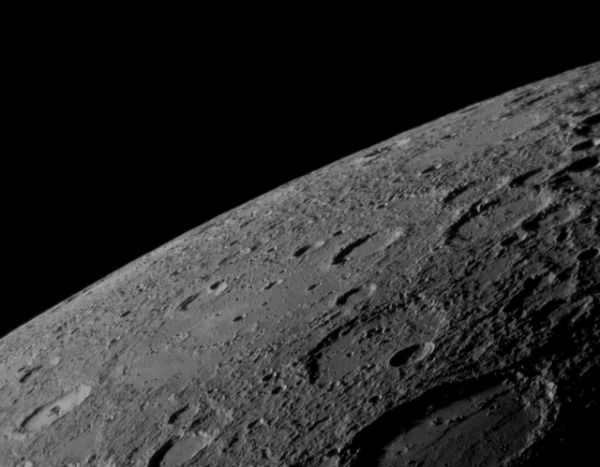
The surface of Mercury bears a resemblance to the lunar surface (image of the AMS Messenger).
Chemical composition
The chemical makeup of the smallest planet in the solar system consists of rarefied helium, sodium, hydrogen, and potassium, which make up 95.5% of its composition. The remaining half percent comprises of neon, argon, carbon dioxide, magnesium, calcium, nitrogen, krypton, and xenon. Surprisingly, scientists were unable to detect any oxygen, despite the anticipation of its presence (42%) by the Mariner 10. Instead, the MESSENGER probe discovered the presence of water molecules. It was revealed that the atmosphere of Mercury contains water vapor and a significant number of water-related ions.
On average, atoms live for about 200 days before they ultimately escape into outer space. Once their time is up, there is no way to retrieve them. However, new elements find their way to us through various methods. Sodium compounds with a charge, for instance, gather at the poles. Similarly, calcium and magnesium don’t collide with one another, but rather with solid surfaces. Helium and hydrogen, on the other hand, enter the planetary envelope through the solar wind. Finally, argon is produced through radioactive decay.

